I have been contacted by several different Omni-E Faceting Machine owners. All of us have experienced water leaks and bearing problems on our machines, and those of us who have sent them back to the Jersey Instruments factory for repair have been told that we have flooded our bearings.
The owner of Jersey Instruments considers this owner abuse of the machine and charges for any repair work related to replacing the bearings.
As you will see from the following photos, I disagree completely. Due to a significant design flaw in the Omni Faceting Machine, I expect *EVERYONE* to have flooded bearings sooner or later. You are free to draw your own conclusions.
Please look carefully at this photo and tell me what your first thoughts are. I have cut 3 stones since getting it back from Jersey Instruments.
You are looking at the splash pan with the Spindle and Platen assembly removed.
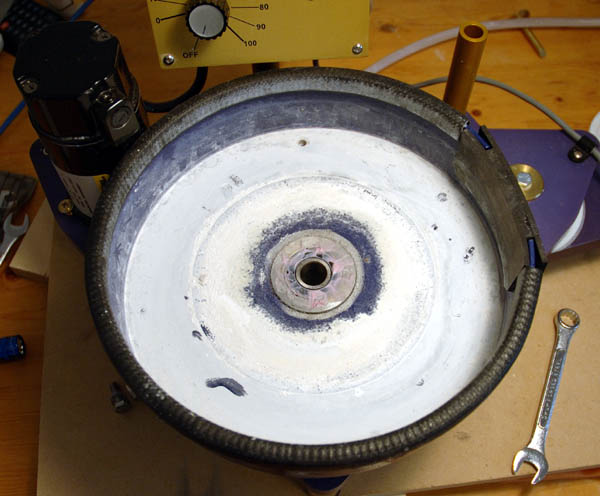
Here is a close-up of the Spindle Housing where it joins the Splash Pan. I have done nothing to it at this point except remove the Platen and Spindle.
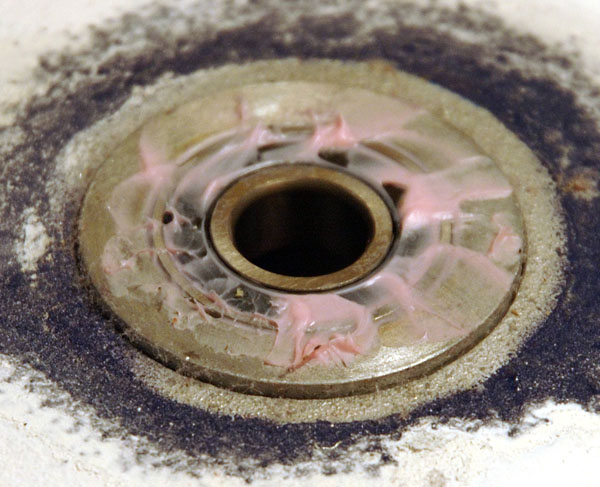
The pink smears are some sort of lithium grease. The webby-bits are lint and dust from the air, and the white stuff is ground gem dust.
Omni Bearing Design Flaw
There is no lip or any sort of rubber dam/gasket/barrier to prevent water from reaching the bearing or leaking down between the Spindle Housing and Splash Pan.
There is no protection to prevent water from reaching the Bearings.
The Splash Pan has a mild gradient to it, the center being about 1/8″ higher than the edge. But otherwise there is no protection for the Spindle Housing or bearings from water flooding. No rubber o-ring or gasket, not even a layer of grease to prevent water from flowing between the Splash Pan and the Spindle Housing.
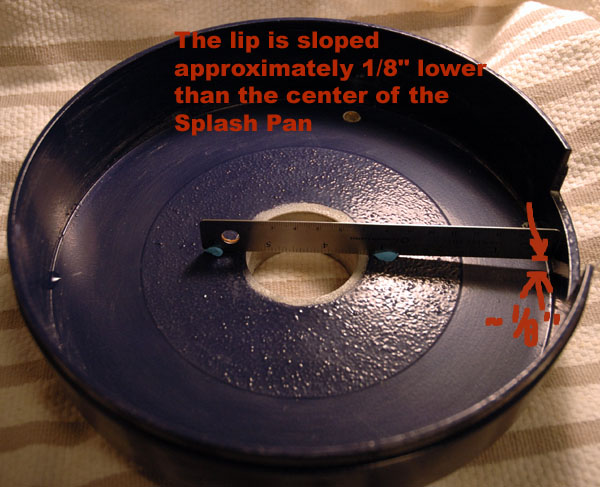
If you use a lot of water (when roughing for example) or your hose isn’t draining properly, you WILL flood your Spindle Housing and Bearings. There is nothing to prevent water from flowing there. Eventually, you WILL flood your Bearings and Spindle Housing. PERIOD.
Here is the Spindle Housing removed from the Splash Pan. As I stated above, I have cut 3 stones on the machine since it was returned to me from the factory.
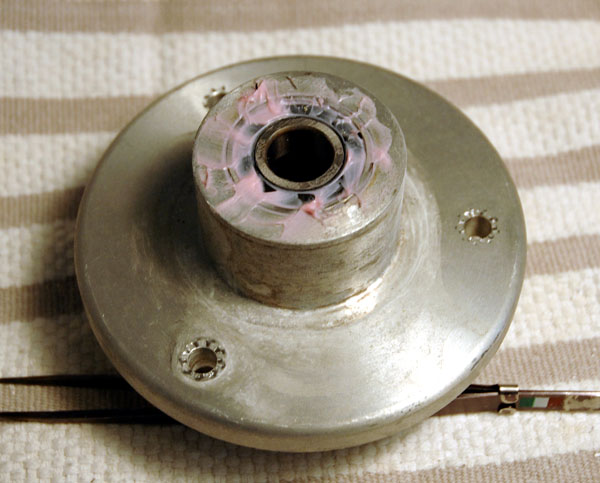
Note the rock powder and corrosion stains from water leaking between the Splash Pan and the Spindle Housing. This is a machined part – it should be completely smooth and shiny, not pitted and rough.
Here’s a side view close-up of the Spindle Housing. Notice how quickly the corrosion has started to pit the machined part.
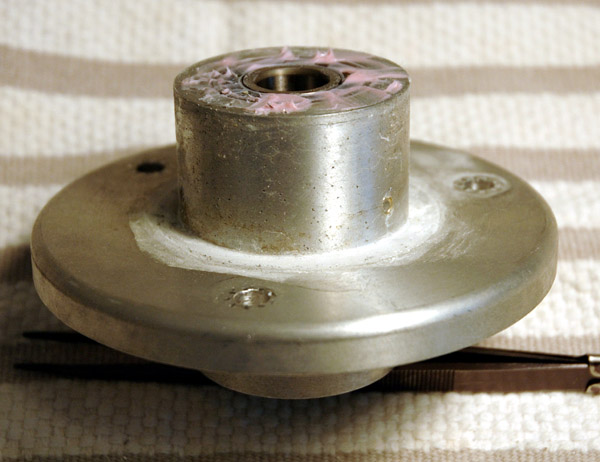
Here’s a close-up of the Splash Pan where it contacts the Spindle Housing. Notice the corrosion here too.
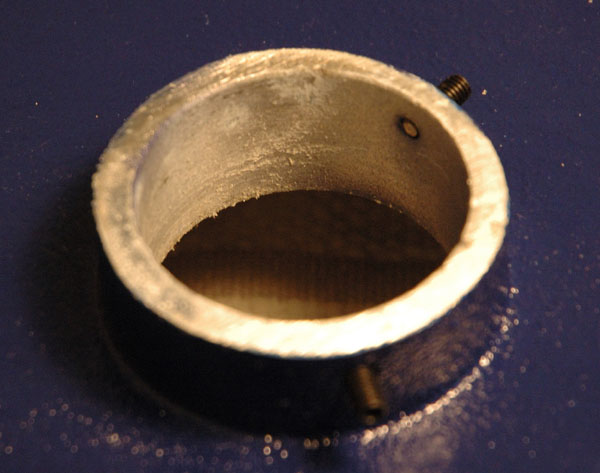
This is due to the two parts – the Spindle Housing and Splash Pan – being dissimilar metals. Add in a bit of water and you end up with galvanic corrosion occurring, causing the pitting.
Left long enough, this will destroy the Spindle Housing and Splash Pan. At very least, it will fuse the two together with corrosion. THIS SHOULD *NEVER* HAPPEN IN A GOOD DESIGN.
IS THIS THE SORT OF DESIGN YOU EXPECT FROM A PRECISION INSTRUMENT COSTING $2200?
There obviously was a reasonable amount of water that made it from my Splash Pan down the Spindle Housing to the Base, though not enough to drip into the bottom cover and wet my work table and alert me of the problem. You can see the beginning of rust and corrosion on the three set screws in this photo.
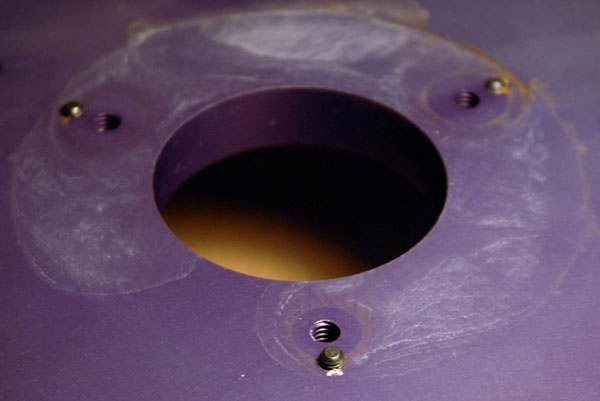
There should at least be a waterproof collar around the hole the Spindle Housing enters to prevent any water from making its way between the parts.
Suggested fixes (see the Omni Modifications section for details):
- Put a bit of silicon rubber sealer between the Splash Pan and the Spindle Housing to seal the gap (this won’t stop water from getting into the bearing if water gets this far)
- Put a bead of silicon rubber around the Splash Pan hole, say about 1″ from the edge. This will give the Platen enough clearance to not rub against it
- Create a new Splash Pan. I will be working on this in the coming weeks. I am thinking of a 4″ ID PVC tubing glued inside a 10″-11″ plastic container of some description.
Remember, I have only cut 3 stones so far. What would this look like after a year of cutting?

I am wondering if a little Phil Wood’s grease might be a benefit. It is used in cycling for its waterproof nature. It might add some extra protection from any water that gets past the silicon lip as with the pink litium(?) grease you have used. Not much help, but maybe a little?
I’m trying to find a better, heavier-duty bearing to put in place here. That might help a bit, but the real problem is that water should *never* be allowed to build up on the bearing. It’s full of very hard and abrasive gem and diamond dust, and will destroy any bearing sooner or later.
I am in the process of trying to build a different splash pan, with a collar that extends UP instead of DOWN. That way it will capture and isolate water from the Spindle Housing and Bearings and prevent water from ever touching them.
-Allan
LOL! This “state of the art” faceting machine is now a Do It Yourself kit! Maybe it should ship with a toolbox…
Now to be fair, it looks like each has a weakness. I know I kept getting water on me from the UT in class that was 6 ft behind me and it sounds like a vacuum on high. The Graves Mk I’s mast connectors get a lot of slop in them. The part I do not like is blaming the users for problems of design or implementation.
One of the problems with the Omni Faceting Machine is the choice of bearings. The bearings used are NSK 6202VV. They are 15 mm inner diameter bearings with non-contact seals on either side.
They should have used 6202DDU models – these bearings have CONTACT seals.
The difference? The 6202VV seal does not touch the bearing’s inner ring. So when water floods over the Spindle Housing onto the bearing, it gets between the seal and the inner ring, carrying swarf with it. After a few hours of running like this, you’re bearing is shot. These seals were meant for dust protection, not water.
A 6202DDU seal contacts both the outer and inner ring. If water splashes on the bearing, it’s much more difficult for it to enter the bearing and start damaging it.
Replacing the bearings with 6202DDU models will help reduce the frequency of bearing damage, but the overall design fault of the Omni Faceting Machine still needs to be rectified as water should never be allowed to reach the bearings in the first place.
-Allan
I started faceting early this year for the first time using the club’s machine, a Gemmaster. A couple of members own the Halls machine and are very happy with it. I am in the process of building a machine of my own using the better features of various machines. This web site is very enlightening to help me avoid some of the pitfalls mentioned in the article.
Thanks for some great ideas and information
vvet